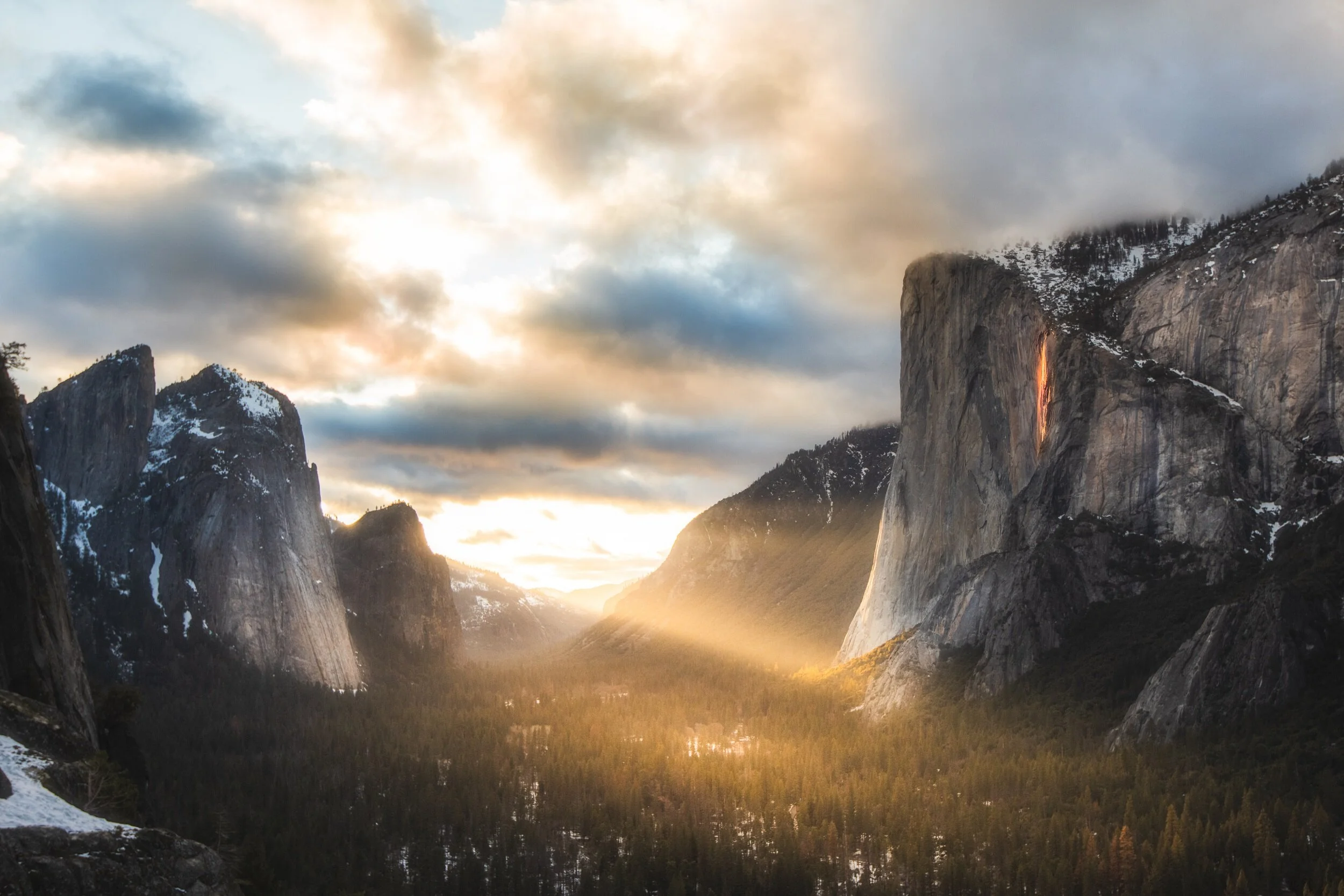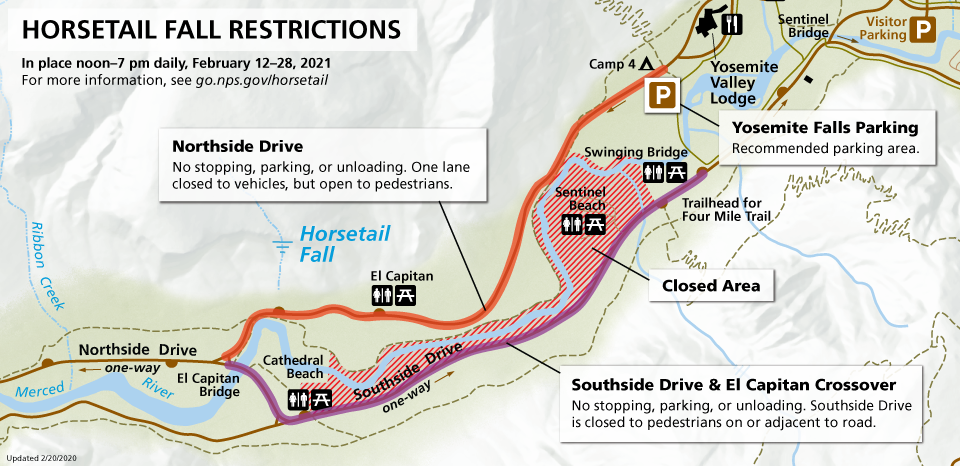6 Min Read
Thousands gather every year for a chance to witness one of Yosemite National Park’s most incredible natural phenomena known as Firefall at Horsetail Fail. If you’ve ever visited Yosemite National Park in the summer, you may not have noticed or heard of Horsetail Fall. It’s a thin silver of a waterfall that flows off the face of El Capitan. Just a few weeks every year in February, this magical event occurs where the sun directs a beam of light at the waterfall turning in into what can only be described as molten lava.
As a photographer living in San Francisco for almost five years, Firefall was at the top of my bucket list. On February 19th, I decided to head towards Yosemite National Park at what would be my third attempt at capturing Firefall.
You might be thinking “third attempt”, I thought it happened every year? Firefall only has the chance of occurring in the month of February but, a lot of factors and conditions have to align. If you want to dive straight into learning how to capture Firefall yourself, jumped ahead!
My Firefall 2021 Adventure
At around 5PM on Friday, Tianna (@realnoice) and I jumped in the car and plugged in our destination for the evening, an Airbnb in Mariposa. It was almost two hours from Yosemite Valley but, we couldn’t pass up on such a gorgeous and cheap Airbnb. We meet up with a few friends, cheers with few Guinness beers, and got some shut-eye.
We started off the morning heading straight into the valley enjoying popular sights such as Tunnel View, Yosemite Falls, and Sentinel Bridge as we eagerly awaited for sunset. Our original plan to view the event from the El Capitan Picnic Area, one of the most popular locations to catch a great viewing! Instead, we ran into several more friends who had this idea of getting a better vantage point above the valley floor. It didn’t take much convincing and with a few hours left to sunset we started our trek up near Four Mile Trail.
Nobody warned me we were going to climb straight up a frozen waterfall! Completely unprepared without micro-spikes I found myself slipping and sliding over boulders and snow. For most of the climb, I had a constant feeling of how I was barley escaping death with each fall that didn’t send me flying down the mountain. With boots completely soaked and frozen toes, we finally made it to the top above the tree line with a view of the valley floor. The only problem? The sky was completely cloudy and dark. I couldn’t believe it, I just spent hours cheating death with toes numb for nothing.
With only an hour till sunset we decided to just wait it out. We spent the time refueling on snacks and chatting with a few other photographers. Only minutes left till sunset we finally got this stunning and mesmerizing light beam through the clouds! It seemed like everything was coming together when cheers started to erupt from the all around the valley floor. The feeling could only be described as being in the crowd of an EDM festival singing to your favorite song. As I watched the light hit the falls, I was in complete awe and star-struck. Shutters fired off and everyone joined in with hooting and hollering.
Why is it called Yosemite Firefall?
Yosemite Firefall gets it name from another historical event. It was an event that started in the summer of 1872 and continued on for almost 100 years! Burning embers were catapulted from the top of Glacier Point to the valley floor over 3,000 feet below. When you viewed the event from a distance, it gave the appearance of a fiery waterfall. The practice ended in January 1968, when the director of the National Park Service requested the event be halted due to the over tourism and it was not a natural occurrence. The NPS desired to preserve the valley in its natural state.
Just a few years later, Galen Rowell is credited to accidentally stumbling across a new Firefall phenomenon. Completely by accident Galen was driving around the valley floor when he sighted a small waterfall that appeared molten in the sunset. He photographed the experienced and it became the first widely circulated color photograph of the natural Firefall.
HOW TO CAPTURE THE BUCKET LIST SHOT
How to see Firefall next year
Three conditions must align for Firefall to occur such as positioning of the sun, enough water, and clear skies. The sun comes into alignment with the falls during mid-to-late February each year, in 2021 the best viewing dates were February 12 through 28.
Be sure to bookmark this post! I’ll be updating it for next year. The most important factor is if Horsetail Fall has enough flowing water. Firefall relies on snow during the winter with a combination of warm days to create a snowmelt, sending water over the edge of El Capitan bringing the fall to life. Finally, with a little bit of luck and clear skies will allow the sun to cast its beam and illuminate the falls.
In frame: @realnoice
Oftentimes cloudy skies will deter people away but, it’s what gave me such a stunning view. Most of all, it’s not over till its over. I heard horror stories this year of people packing up just 30-minutes before sunset due to cloudy skies. Only later to find out they cleared just enough for the sun to shine through. If you’re already there, just keep those fingers crossed.
If possible, it’s recommended to plan to spend multiple days in Yosemite National Park to increase your chances of seeing Firefall!
Firefall Parking and Viewing Areas
Yosemite Firefall attracts thousands of individuals to the park which creates a ton of traffic and congestion. Yosemite and the National Park Service teams have done an incredible job managing the event, creating an enjoyable experience for everyone. Be sure to arrive early, there are limited number of parking spots. To view Horsetail Fall, it is recommended to park at Yosemite Falls parking (just west of Yosemite Valley Lodge) and walk roughly 1.5 miles (each way) to the viewing area near El Capitan Picnic Area. If you didn’t bring your own snacks, stop at Yosemite Valley Lodge area for snacks and coffee! When you make the trek, there will be vault toilets, along with trash and recycling dumpsters, are available at the El Capitan picnic area.
What should I bring to View Yosemite Firefall
Come prepared when viewing Yosemite Firefall, here’s a few notes and tips
Dress warm with boots, gloves, hats, and a puffer coat! February is in the middle of winter and it will often to cold especially during sunset. Be sure to check the weather for the temperatures
Flashlight or headlamp for walking or hiking back in the dark
Lawn chair, get to your location early and scope it out! Then relax in your chair and wait for sunset.
Food, water, and drinks. Stay hydrated and fill up on snacks! Have a celebratory beer during the event.
Games, my friends and I got to our spot several hours early. So we snuck in a few games of Monopoly Deal to pass the time.
Camera, you’ll definitely want to capture this moment! So make sure your cell phone or camera is charged.
Tripod (optional), some photographers will swear by a tripod. I would never use a tripod again if I could. The only purpose it served me during this event was a placeholder for my spot.
For photographers, I would definitely recommend a 70-200mm zoom lens to get close to the falls! Depending on your viewing point, you may also opt for a wide angle or mid range lens to capture more of the surrounding sky and scenery. I’ve included settings in the captions for the photos below!
If you decide to visit Yosemite and need any tips feel free to direct message me on Instagram @nickfjord!









